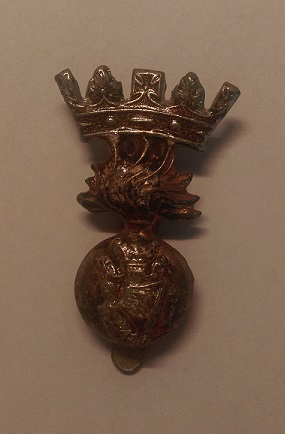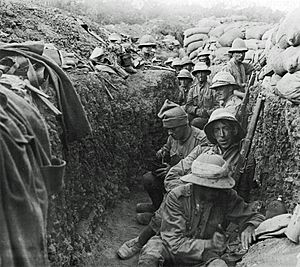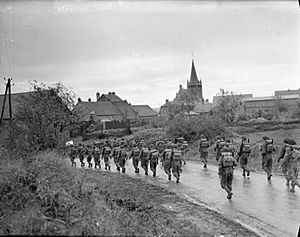Royal Irish Fusiliers facts for kids
Quick facts for kids Princess Victoria's (Royal Irish Fusiliers)Royal Irish Fusiliers (Princess Victoria's) |
|
|---|---|

Royal Irish Fusiliers Cap Badge
|
|
| Active | 1881–1968 |
| Country | |
| Branch | |
| Type | Light infantry Line infantry (originally) |
| Role | Anti-tank warfare Artillery observer<brClose-quarters combat Cold-weather warfare Counterinsurgency Desert warfare Internal security Patrolling Raiding Reconnaissance Trench warfare Urban warfare |
| Size | 1–2 Regular battalions Up to 3 Militia and Special Reserve battalions |
| Garrison/HQ | Gough Barracks, Armagh |
| Nickname(s) | The Old Fogs, The Rollickers |
| Motto(s) | Faugh-a-Ballagh (Clear the way) |
| March | Quick: St Patrick's Day; Garry Owen; Barrosa |
| Insignia | |
| Hackle | Emerald Green |
The Royal Irish Fusiliers (Princess Victoria's) was a special group of soldiers, called an infantry regiment, in the British Army. It was formed in 1881 when two other regiments, the 87th and 89th Foot, joined together. Its name changed a bit over time. From 1881 to 1920, it was called 'Princess Victoria's (Royal Irish Fusiliers)'. Later, it became 'Royal Irish Fusiliers (Princess Victoria's)'. It was one of eight Irish regiments in the British Army.
In 1968, this regiment joined with two other groups, the Royal Inniskilling Fusiliers and the Royal Ulster Rifles. Together, they formed a new regiment called the Royal Irish Rangers.
The Royal Irish Fusiliers: A Look Back
How the Regiment Began
The regiment started in 1881. It was created by combining two older regiments. These were the 87th (Prince of Wales's Irish) Regiment of Foot and the 89th (The Princess Victoria's) Regiment of Foot.
The soldiers got their nickname, "The Faughs," from an old Irish battle cry. This cry was "Faugh A Ballagh", which means "Clear the Way!" They wore a green feather on their hats and had an Irish harp on their badge. Their main base was at Gough Barracks in Armagh.
Early Battles and Service
The 1st Battalion of the regiment fought in the Anglo-Egyptian War in 1882.
Both battalions also served in South Africa during the Second Boer War (1899–1902). The 1st Battalion was part of the Battle of Talana Hill in 1899. They also helped in the Relief of Ladysmith. The 2nd Battalion fought in the Battle of the Tugela Heights in 1900.
After the war, many soldiers returned home. The 2nd Battalion later moved to British India.
In 1908, the army changed how it organized its reserve forces. The regiment then had two reserve battalions.
The First World War (1914-1918)
Regular Army Battalions in Action
The 1st Battalion went to France in August 1914. They were part of the 4th Division. They faced heavy losses at the Battle of Le Cateau.
The 2nd Battalion also went to France in December 1914. They later moved to Thessaloniki in December 1915. From there, they went to Egypt and then to Mandatory Palestine in 1917.
The 3rd (reserve) Battalion helped stop the Easter Rising in Dublin in 1916. Two of their soldiers died, and six were injured.
New Battalions Join the Fight
The 5th and 6th Battalions landed at Suvla Bay in Gallipoli in August 1915. They later moved to Salonika in October 1915.
The 7th and 8th Battalions arrived in France in February 1916. They fought on the Western Front. The 9th Battalion also landed in France in October 1915. They were part of the 36th (Ulster) Division.
Between the World Wars
After Ireland became independent in 1922, many Irish regiments in the British Army were disbanded. However, the Royal Irish Fusiliers (Princess Victoria's) successfully argued to keep one of their battalions. The 2nd Battalion was disbanded but was later re-formed in 1938.
The Second World War (1939-1945)
The 1st Battalion's Journey
The 1st Battalion went to France in early 1940. They were part of the British Expeditionary Force. They fought in the Battle of Dunkirk and had to be evacuated.
After Dunkirk, the battalion became part of the 38th (Irish) Brigade. This brigade fought in the Tunisia Campaign. They then joined the 78th Battleaxe Division. With this division, they fought bravely in Sicily, including the Battle of Centuripe in August 1943.
Their success continued with the landings in Italy. The battalion took part in many river crossings and battles. One of their most famous fights was the Battle of Monte Cassino. This was one of the toughest battles of the entire war. Their final battle in Italy was Operation Grapeshot.
The 2nd Battalion's Role
The 2nd Battalion served during the Siege of Malta from 1940 to 1943. They were part of the 4th (Malta) Infantry Brigade. Sadly, the battalion suffered heavy losses in the Battle of Leros and the Battle of Kos in 1943. They had to be re-formed later.
After the Wars
In September 1948, the 1st and 2nd battalions joined together to become one 1st Battalion. The regiment served in many places around the world. They were in Jordan in 1949 and Gibraltar later that year. They also served in Germany in the 1950s.
In July 1954, they went to Korea. In January 1955, they were sent to Kenya to help with the Mau Mau Uprising. They also served in Libya in 1958 and Cyprus in 1964 for peacekeeping duties. Their last deployments were to Swaziland in 1966 and Aden in 1966.
Finally, in July 1968, the Royal Irish Fusiliers (Princess Victoria's) joined with other regiments. They became part of the Royal Irish Rangers.
Regimental Museum
The Royal Irish Fusiliers Museum is located in Armagh, Northern Ireland. It displays uniforms, medals, and other items from the regiment's history. You can also see the two Victoria Crosses won by soldiers from the regiment there.
Victoria Cross Heroes
The Victoria Cross is the highest award for bravery in the British military. Two soldiers from the Royal Irish Fusiliers received this honor:
- Private Robert Morrow of the 1st Battalion. He earned his Victoria Cross in 1915 at Messines.
- Lieutenant Geoffrey Cather of the 9th Battalion. He received his award in 1916 at Hamel during the Somme.



